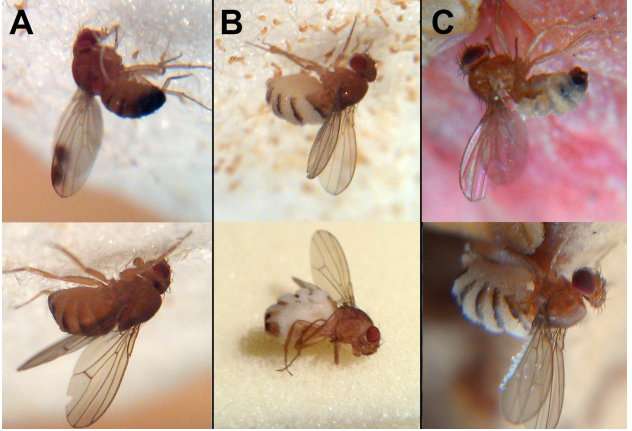December 20, 2017 report
How fungus manipulate fruit flies into hosting spores and releasing them

A team of researchers at the University of California has learned more about the means by which a type of fungus invades fruit flies, takes over their bodies and uses them to reproduce. In their paper uploaded to the bioRxiv preprint server, the group describes their study of the relationship between the fungus and fruit flies and what they learned.
Scientists have discovered many examples of one creature taking control of another for its own purposes—recently, a team documented a parasite controlling the muscles of ants. In this new effort, the researchers describe the process by which a type of fungus takes control of a fruit fly and uses it to launch its spores.
As the researchers note, they were studying one type of fly when they noticed it had been infected by a species of the fungus Entomophthora muscae. They noted that the fly had died in a strange position, with its wings up. Noting the fly was closely related to the fruit fly, the researchers collected samples of the fungus and put them in a container with fruit flies to see if it would infect them, as well. Finding that it did was fortuitous, the group notes, because so much is known about fruit flies due to the many experiments based on them. This gave the researchers an opportunity to study a fungal infection up close.
The group was able to obtain snapshots of the process over time by dissecting the flies at various stages of infection, which began when a spore landed on the fly's abdomen. They discovered that on the first day, there was little to note except for the start of an immune response. Just 24 hours later, though, the fungus had made its way to the brain and hemolymph. By 72 hours, the fungus had made its way into nearly every part of the body, eating fat and other parts as it went. It was also starting to make its way into the nervous system. At 96 hours, the fungus had taken over, causing the fly to ascend to a nearby high point. Once that high point was reached, the fungus produced a glue-like substance that was used to anchor the fly to its perch. That was followed by raising the fly's wings, presumably to get them out of the way. Then, the abdomen swelled as fungal conidiophores sprouted, which a little time later burst, ejecting spores into the air at a high rate of speed.
The researchers were not able to figure out how the fungus actually controlled the fly, but believe it somehow did so by controlling the nervous system.
More information: Carolyn Elya et al. A fungal pathogen that robustly manipulates the behavior of Drosophila melanogaster in the laboratory, bioRxiv (2017). DOI: 10.1101/232140 , www.biorxiv.org/content/early/2017/12/15/232140
Abstract
Many microbes induce striking behavioral changes in their animal hosts, but how they achieve these effects is poorly understood, especially at the molecular level. This is due in large part to the lack of a robust system amenable to modern molecular manipulation. We recently discovered a strain of the behavior-manipulating fungal fly pathogen Entomophthora muscae infecting wild adult Drosophila in Northern California, and developed methods to reliably propagate the infection in lab.-reared Drosophila melanogaster. Our lab.-infected flies manifest the moribund behaviors characteristic of E. muscae infections: on their final day of life they climb to a high location, extend their proboscides and become affixed to the substrate, then finally raise their wings to strike a characteristic death pose that clears a path for spores that are forcibly ejected from their abdomen to land on and infect other flies. Using a combination of descriptive, histological, molecular and genomic techniques, we have carefully characterized the progress of infection in lab.-reared flies in both the fungus and host. Enticingly, we reveal that E. muscae invades the fly nervous system early in infection, suggesting a direct means by which the fungus could induce behavioral changes. Given the vast toolkit of molecular and neurobiological tools available for D. melanogaster, we believe this newly established E. muscae system will permit rapid progress in understanding how microbes manipulate animal behavior.
© 2017 Phys.org




















